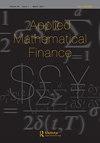论隐含波动率和局部波动率的偏度和曲率
Q3 Mathematics
引用次数: 2
摘要
摘要本文研究了局部波动面短端与隐含波动面之间的关系。我们的结果基于Malliavin微积分技术,恢复了粗波动率的最近1H+3/2规则(其中H表示波动过程的Hurst参数)(见F. Bourgey, S. De Marco, P. Friz和P. Pigato. 2022)。“粗糙波动下的局部波动。[j] .浙江大学学报(自然科学版);MF] https://doi.org/10.48550/arXiv.2204.02376.),即货币隐含波动率的短期倾斜斜率为局部波动率相应斜率的1H+3/2。此外,我们看到隐含波动率的现价短端曲率可以用本地波动率的短端偏度和曲率表示,反之亦然。关键词:随机波动率局部波动率粗糙波动率malliavin演算披露声明作者未报告潜在的利益冲突。注1例如,我们可以假设在0到第一个蒙特卡罗之间有一个局部波动率,或者甚至可以使用以下渐近表达式的离散化:limT→0I0(T,K)=log (KST)∫STk1σ(T,u)du 2。另一种得到偏态的方法是在E((ST−K)+)=BS(T,K,I(T,K))中对K求导。那么我们就得到了∂kI(T,K)=−E(I(ST>K))−∂KBS(T,K,I(T,K))∂σBS(T,K,I(T,K))的表达式。注意项E(I(ST>K))可以在我们得到期权价格的相同模拟中估计。我们已经检查了这两种方法,并确认它们会导致相同的结果。额外信息资金本工作得到了阿根廷国家开发署Investigación的支持[资助号PID2020-118339GB-I00]。本文章由计算机程序翻译,如有差异,请以英文原文为准。
On the Skew and Curvature of the Implied and Local Volatilities
ABSTRACTIn this paper, we study the relationship between the short-end of the local and the implied volatility surfaces. Our results, based on Malliavin calculus techniques, recover the recent 1H+3/2 rule (where H denotes the Hurst parameter of the volatility process) for rough volatilities (see F. Bourgey, S. De Marco, P. Friz, and P. Pigato. 2022. “Local Volatility under Rough Volatility.” arXiv:2204.02376v1 [q-fin.MF] https://doi.org/10.48550/arXiv.2204.02376.), that states that the short-time skew slope of the at-the-money implied volatility is 1H+3/2 of the corresponding slope for local volatilities. Moreover, we see that the at-the-money short-end curvature of the implied volatility can be written in terms of the short-end skew and curvature of the local volatility and vice versa. Additionally, this relationship depends on H.KEYWORDS: Stochastic volatilitylocal volatilityrough volatilityMalliavin calculus Disclosure statementNo potential conflict of interest was reported by the author(s).Notes1 For example we can suppose a local volatility flat between 0 to first Monte Carlo, or even to use a discretization of the following asymptotic expression limT→0I0(T,K)=log(KST)∫STk1σ(T,u)du 2 Another way to get the skew is to take the derivative with respect to K in E((ST−K)+)=BS(T,K,I(T,K)). Then we get the following expression for the skew ∂kI(T,K)=−E(I(ST>K))−∂KBS(T,K,I(T,K)∂σBS(T,K,I(T,K)). Notice that the term E(I(ST>K)) can be estimated in the same simulation where we get the price of the option. We have checked both approaches and we have confirmed that they lead to identical resultsAdditional informationFundingThis work was supported by Agencia Estatal de Investigación [grant number PID2020-118339GB-I00].
求助全文
通过发布文献求助,成功后即可免费获取论文全文。
去求助
来源期刊

Applied Mathematical Finance
Economics, Econometrics and Finance-Finance
CiteScore
2.30
自引率
0.00%
发文量
6
期刊介绍:
The journal encourages the confident use of applied mathematics and mathematical modelling in finance. The journal publishes papers on the following: •modelling of financial and economic primitives (interest rates, asset prices etc); •modelling market behaviour; •modelling market imperfections; •pricing of financial derivative securities; •hedging strategies; •numerical methods; •financial engineering.
 求助内容:
求助内容: 应助结果提醒方式:
应助结果提醒方式:


